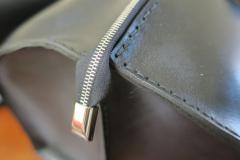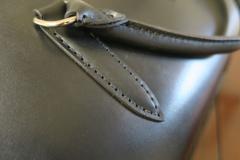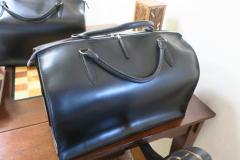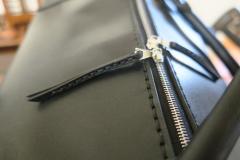
LatigoAmigo
Contributing Member-
Posts
1,012 -
Joined
-
Last visited
Content Type
Profiles
Forums
Events
Blogs
Gallery
Everything posted by LatigoAmigo
-
Maybe you could take a picture so we could see the what kind of leather you have and what the discoloration looks like.
-
Since you continue to have a relationship with him, just tell him you are not ready for such a project. Your mental health is worth more than any paycheck, and it sounds like you would be suffering more that this project is worth, either to you or to him, so just let it go.
-
I use various types of conditioners, and don't know which one will work best on your leather, but you can probably figure that out. Cleaners/conditioners like Lexol work pretty good for some leathers, but I always clean my leather with saddle soap before I start a project. Then I will usually condition with a dressing like Montana Pitch-Blend All Natural Leather Dressing or something similar containing bees wax and mink oil. This dressing does, however, have a tendency to darken the leather, so it might not be your first choice. There are many other cleaners and conditioners to choose from, so you might search this site to see what choices others have made.
-
Hand Sewn Motorcycle Seat with Pleats?
LatigoAmigo replied to doorty's topic in Motorcycles and Biker Gear
What a great find this video is. You'll never wonder "How to Make a Pleated Seat Cover for a Motorcycle" again. Thanks for sharing. -
Very interesting, it looks great. For some fabric options (different materials and weights), you might want to check out Jacquard Inkjet Fabric Systems who carries a variety of fabrics for digital printing: http://www.inkjetfabrics.com/products/digital-fabrics/. As you said, not cheaper, but when lining something like a bag that you hope to sell for top dollar, the lining material can make a difference.
-
Messenger bag 2.0
LatigoAmigo replied to alpha2's topic in Purses, Wallets, Belts and Miscellaneous Pocket Items
That is some very nice work. Good job!- 11 replies
-
- messenger bag
- purse
-
(and 1 more)
Tagged with:
-
I'm not sure if you will find my comments helpful, but here is my two cents... These questions cannot be definitively answered because the answers depend heavily upon what you are making. Most leathers could certainly hold up against some sweaty gym clothes. Do you intend to allow your leatherwork to get drenched in the rain? Canvas is available in different weights and colors, and could be punched and stitched without too many problems, especially waxed canvas. A large bag would typically need more support than a small bag, but it also depends on the design and the leather used. I have found that the California Latigo from The Hide House can pretty much stand up by itself (it is considered belt leather). As to stiffeners, I have limited experience, but know that not all stiffeners adhere equally to all leathers, plus stiffeners vary in rigidity. You will have to experiment to see what works best for your project. The iron-on stiffeners are made of fabric and should not break, but could come loose if they got wet. The only way I know to keep leather straps from stretching is to sew an additional layer to the strap, and for further strength, include something like nylon webbing between the layers. I hope you find my feedback helpful.
-
Heat pressing vinyl lettering onto veg tan leather
LatigoAmigo replied to BoulevardEast's topic in How Do I Do That?
It's sure worth a try. The paint used for screen printing is referred to as "ink" and is water based. Some of it can be heat-set which might help it adhere to the leather. Since a leather hide is not completely flat, you might be challenged to keep your image from distorting. Here is a link to the topic of screen printing on leather: https://jacquardproducts.com/forums/discussion/39874/printing-on-leather/p1 -
Heat pressing vinyl lettering onto veg tan leather
LatigoAmigo replied to BoulevardEast's topic in How Do I Do That?
I don't have much experience with veg-tan, but do have experience with latigo and chrome-tan leathers. Because of the oils and dyes that are a part of the tanning process, the leather is sealed to some degree. This keeps these leathers from accepting the heat processed glues uses for sealing vinyl. -
Looking to buy OEM Leather for Automotive seats repair
LatigoAmigo replied to Kerya's topic in Suppliers
The first time I walked into the Hide House (in Napa, CA) I said to myself, "If I ever needed to reupholster a 1948 Jaguar, this is where I'd get the leather." I don't know if this helps, because you didn't mention what what you were working on. -
Finished Handbag
LatigoAmigo replied to Dave Richardson's topic in Purses, Wallets, Belts and Miscellaneous Pocket Items
The Hide House (hidehouse.com) carries a "Designer Latigo" in a variety of colors, including red, blue, lavender, pink, white, purple, orange and green. -
Computer Drawing Software For Making Leather Patterns
LatigoAmigo replied to Blackey Cole's topic in Computer Help
I can't draw a straight line, so I rely on Adobe Illustrator to do my drawing for me. It is not easier or faster, but the results are BETTER. Worth the extra time (says the hobbyist). Plus the output can be duplicated, and the patterns can be easily scaled. -
This is an interesting thread. Makes me wonder if hot glue (from a hot gluing gun) might work. It dries slightly pliable, and should adhere well to both layers of leather. It comes in different grades, low and high temperature.
- 48 replies
-
-
Does Inkscape have "offset paths"? It is a feature of Illustrator that I find invaluable for creating seam allowances.
-
I'm sure many will find this post very useful, but you might want to clarify that these applications are for veg-tanned leathers, and do not work as well on chrome-tanned leathers.
-
I've discovered that latigo comes in many forms and finishes, so there is no one answer as to the best leather conditioner to use. But what I do know is that I would rather have the leather finish come off on my bench than have it come off on my customer, so I thuroughly clean the leather before any construction, typically using "magic erasers" and saddle soap (in a spray bottle). It can have an effect on the pre-finish, but in the end this allows for the leather to more evenly absorb any finish that I might apply. One trick that I use when applying oil finishes is rather than have to wait (up to 24 hours) to let the leather absorb the oil, I use a dryer rack and run our clothes dryer on low for 30-60 minutes to warm up the leather and encourage penetration. Works like a charm.
-
-
Have you looked at Maverick's lace? http://maverickleathercompany.com/
-
-
Matching latigo totes
LatigoAmigo commented on LatigoAmigo's gallery image in Gallery- Our Leatherwork
-
From the album: Ferrari Tote Bags
-
From the album: Ferrari Tote Bags
-
From the album: Ferrari Tote Bags





